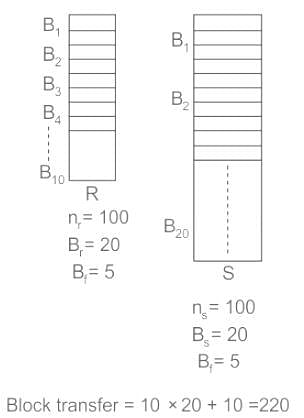Computer Science Engineering (CSE) Exam > Computer Science Engineering (CSE) Questions > Consider a join (relation algebra) between re...
Start Learning for Free
Consider a join (relation algebra) between relations r(R)and s(S) using the nested loop method.
There are 3 buffers each of size equal to disk block size, out of which one buffer is reserved for intermediate results.
Assuming size(r(R))
There are 3 buffers each of size equal to disk block size, out of which one buffer is reserved for intermediate results.
Assuming size(r(R))
- a)relation r(R) is in the outer loop.
- b)relation s(S) is in the outer loop.
- c)join selection factor between r(R) and s(S) is more than 0.5.
- d)join selection factor between r(R) and s(S) is less than 0.5.
Correct answer is option 'A'. Can you explain this answer?
| FREE This question is part of | Download PDF Attempt this Test |
Most Upvoted Answer
Consider a join (relation algebra) between relations r(R)and s(S) usin...
Concept:
Nested loop join algorithm:
No of block transfers = nr x bs + br
Where nr is number of tuples in relation R and bs and br are the number of blocks in relation R and S respectively.
In question it is given that size(r(R))s > br and nr < ns.
Example:
Suppose relation r is in the outer loop:

Suppose relation s is in the outer loop:
Block transfer = 100 x 10 + 20 = 1020
So relation r should be in the outer loop for effective nested loop join algorithm.
Hence option 1 is the correct answer.
Nested loop join algorithm:
No of block transfers = nr x bs + br
Where nr is number of tuples in relation R and bs and br are the number of blocks in relation R and S respectively.
In question it is given that size(r(R))s > br and nr < ns.
Example:
Suppose relation r is in the outer loop:

Suppose relation s is in the outer loop:
Block transfer = 100 x 10 + 20 = 1020
So relation r should be in the outer loop for effective nested loop join algorithm.
Hence option 1 is the correct answer.
Free Test
FREE
| Start Free Test |
Community Answer
Consider a join (relation algebra) between relations r(R)and s(S) usin...
Explanation:
The nested loop join method is a simple join algorithm that works by comparing each tuple from one relation with each tuple from the other relation. It uses nested loops to iterate through all possible combinations of tuples. In this method, one relation is chosen as the outer loop and the other as the inner loop.
Given that there are 3 buffers, with one reserved for intermediate results, we need to consider the impact of buffer usage on the performance of the join operation.
a) Relation r(R) is in the outer loop:
When relation r(R) is in the outer loop, it means that each tuple from r(R) will be read into a buffer and then compared with each tuple from s(S) using the inner loop. As a result, each tuple from r(R) will be read into the buffer once, and for each tuple, the entire relation s(S) will be scanned.
b) Relation s(S) is in the outer loop:
When relation s(S) is in the outer loop, it means that each tuple from s(S) will be read into a buffer and then compared with each tuple from r(R) using the inner loop. As a result, each tuple from s(S) will be read into the buffer once, and for each tuple, the entire relation r(R) will be scanned.
c) Join selection factor between r(R) and s(S) is more than 0.5:
The join selection factor is the ratio of the number of tuples in the result of the join to the number of tuples in the cross-product of the two relations being joined. When the join selection factor is more than 0.5, it means that the result of the join is relatively smaller compared to the cross-product. In this case, it is more efficient to have the relation with a smaller result in the outer loop. Therefore, relation r(R) should be in the outer loop.
d) Join selection factor between r(R) and s(S) is less than 0.5:
When the join selection factor is less than 0.5, it means that the result of the join is relatively larger compared to the cross-product. In this case, it is more efficient to have the relation with a larger result in the outer loop. Therefore, relation s(S) should be in the outer loop.
Conclusion:
Based on the given information, the correct answer is option 'A' - relation r(R) is in the outer loop. This is because it is more efficient to have the relation with a smaller result in the outer loop.
The nested loop join method is a simple join algorithm that works by comparing each tuple from one relation with each tuple from the other relation. It uses nested loops to iterate through all possible combinations of tuples. In this method, one relation is chosen as the outer loop and the other as the inner loop.
Given that there are 3 buffers, with one reserved for intermediate results, we need to consider the impact of buffer usage on the performance of the join operation.
a) Relation r(R) is in the outer loop:
When relation r(R) is in the outer loop, it means that each tuple from r(R) will be read into a buffer and then compared with each tuple from s(S) using the inner loop. As a result, each tuple from r(R) will be read into the buffer once, and for each tuple, the entire relation s(S) will be scanned.
b) Relation s(S) is in the outer loop:
When relation s(S) is in the outer loop, it means that each tuple from s(S) will be read into a buffer and then compared with each tuple from r(R) using the inner loop. As a result, each tuple from s(S) will be read into the buffer once, and for each tuple, the entire relation r(R) will be scanned.
c) Join selection factor between r(R) and s(S) is more than 0.5:
The join selection factor is the ratio of the number of tuples in the result of the join to the number of tuples in the cross-product of the two relations being joined. When the join selection factor is more than 0.5, it means that the result of the join is relatively smaller compared to the cross-product. In this case, it is more efficient to have the relation with a smaller result in the outer loop. Therefore, relation r(R) should be in the outer loop.
d) Join selection factor between r(R) and s(S) is less than 0.5:
When the join selection factor is less than 0.5, it means that the result of the join is relatively larger compared to the cross-product. In this case, it is more efficient to have the relation with a larger result in the outer loop. Therefore, relation s(S) should be in the outer loop.
Conclusion:
Based on the given information, the correct answer is option 'A' - relation r(R) is in the outer loop. This is because it is more efficient to have the relation with a smaller result in the outer loop.
Attention Computer Science Engineering (CSE) Students!
To make sure you are not studying endlessly, EduRev has designed Computer Science Engineering (CSE) study material, with Structured Courses, Videos, & Test Series. Plus get personalized analysis, doubt solving and improvement plans to achieve a great score in Computer Science Engineering (CSE).

|
Explore Courses for Computer Science Engineering (CSE) exam
|

|
Consider a join (relation algebra) between relations r(R)and s(S) using the nested loop method.There are 3 buffers each of size equal to disk block size, out of which one buffer is reserved for intermediate results.Assuming size(r(R))a)relation r(R) is in the outer loop.b)relation s(S) is in the outer loop.c)join selection factor between r(R) and s(S) is more than 0.5.d)join selection factor between r(R) and s(S) is less than 0.5.Correct answer is option 'A'. Can you explain this answer?
Question Description
Consider a join (relation algebra) between relations r(R)and s(S) using the nested loop method.There are 3 buffers each of size equal to disk block size, out of which one buffer is reserved for intermediate results.Assuming size(r(R))a)relation r(R) is in the outer loop.b)relation s(S) is in the outer loop.c)join selection factor between r(R) and s(S) is more than 0.5.d)join selection factor between r(R) and s(S) is less than 0.5.Correct answer is option 'A'. Can you explain this answer? for Computer Science Engineering (CSE) 2024 is part of Computer Science Engineering (CSE) preparation. The Question and answers have been prepared according to the Computer Science Engineering (CSE) exam syllabus. Information about Consider a join (relation algebra) between relations r(R)and s(S) using the nested loop method.There are 3 buffers each of size equal to disk block size, out of which one buffer is reserved for intermediate results.Assuming size(r(R))a)relation r(R) is in the outer loop.b)relation s(S) is in the outer loop.c)join selection factor between r(R) and s(S) is more than 0.5.d)join selection factor between r(R) and s(S) is less than 0.5.Correct answer is option 'A'. Can you explain this answer? covers all topics & solutions for Computer Science Engineering (CSE) 2024 Exam. Find important definitions, questions, meanings, examples, exercises and tests below for Consider a join (relation algebra) between relations r(R)and s(S) using the nested loop method.There are 3 buffers each of size equal to disk block size, out of which one buffer is reserved for intermediate results.Assuming size(r(R))a)relation r(R) is in the outer loop.b)relation s(S) is in the outer loop.c)join selection factor between r(R) and s(S) is more than 0.5.d)join selection factor between r(R) and s(S) is less than 0.5.Correct answer is option 'A'. Can you explain this answer?.
Consider a join (relation algebra) between relations r(R)and s(S) using the nested loop method.There are 3 buffers each of size equal to disk block size, out of which one buffer is reserved for intermediate results.Assuming size(r(R))a)relation r(R) is in the outer loop.b)relation s(S) is in the outer loop.c)join selection factor between r(R) and s(S) is more than 0.5.d)join selection factor between r(R) and s(S) is less than 0.5.Correct answer is option 'A'. Can you explain this answer? for Computer Science Engineering (CSE) 2024 is part of Computer Science Engineering (CSE) preparation. The Question and answers have been prepared according to the Computer Science Engineering (CSE) exam syllabus. Information about Consider a join (relation algebra) between relations r(R)and s(S) using the nested loop method.There are 3 buffers each of size equal to disk block size, out of which one buffer is reserved for intermediate results.Assuming size(r(R))a)relation r(R) is in the outer loop.b)relation s(S) is in the outer loop.c)join selection factor between r(R) and s(S) is more than 0.5.d)join selection factor between r(R) and s(S) is less than 0.5.Correct answer is option 'A'. Can you explain this answer? covers all topics & solutions for Computer Science Engineering (CSE) 2024 Exam. Find important definitions, questions, meanings, examples, exercises and tests below for Consider a join (relation algebra) between relations r(R)and s(S) using the nested loop method.There are 3 buffers each of size equal to disk block size, out of which one buffer is reserved for intermediate results.Assuming size(r(R))a)relation r(R) is in the outer loop.b)relation s(S) is in the outer loop.c)join selection factor between r(R) and s(S) is more than 0.5.d)join selection factor between r(R) and s(S) is less than 0.5.Correct answer is option 'A'. Can you explain this answer?.
Solutions for Consider a join (relation algebra) between relations r(R)and s(S) using the nested loop method.There are 3 buffers each of size equal to disk block size, out of which one buffer is reserved for intermediate results.Assuming size(r(R))a)relation r(R) is in the outer loop.b)relation s(S) is in the outer loop.c)join selection factor between r(R) and s(S) is more than 0.5.d)join selection factor between r(R) and s(S) is less than 0.5.Correct answer is option 'A'. Can you explain this answer? in English & in Hindi are available as part of our courses for Computer Science Engineering (CSE).
Download more important topics, notes, lectures and mock test series for Computer Science Engineering (CSE) Exam by signing up for free.
Here you can find the meaning of Consider a join (relation algebra) between relations r(R)and s(S) using the nested loop method.There are 3 buffers each of size equal to disk block size, out of which one buffer is reserved for intermediate results.Assuming size(r(R))a)relation r(R) is in the outer loop.b)relation s(S) is in the outer loop.c)join selection factor between r(R) and s(S) is more than 0.5.d)join selection factor between r(R) and s(S) is less than 0.5.Correct answer is option 'A'. Can you explain this answer? defined & explained in the simplest way possible. Besides giving the explanation of
Consider a join (relation algebra) between relations r(R)and s(S) using the nested loop method.There are 3 buffers each of size equal to disk block size, out of which one buffer is reserved for intermediate results.Assuming size(r(R))a)relation r(R) is in the outer loop.b)relation s(S) is in the outer loop.c)join selection factor between r(R) and s(S) is more than 0.5.d)join selection factor between r(R) and s(S) is less than 0.5.Correct answer is option 'A'. Can you explain this answer?, a detailed solution for Consider a join (relation algebra) between relations r(R)and s(S) using the nested loop method.There are 3 buffers each of size equal to disk block size, out of which one buffer is reserved for intermediate results.Assuming size(r(R))a)relation r(R) is in the outer loop.b)relation s(S) is in the outer loop.c)join selection factor between r(R) and s(S) is more than 0.5.d)join selection factor between r(R) and s(S) is less than 0.5.Correct answer is option 'A'. Can you explain this answer? has been provided alongside types of Consider a join (relation algebra) between relations r(R)and s(S) using the nested loop method.There are 3 buffers each of size equal to disk block size, out of which one buffer is reserved for intermediate results.Assuming size(r(R))a)relation r(R) is in the outer loop.b)relation s(S) is in the outer loop.c)join selection factor between r(R) and s(S) is more than 0.5.d)join selection factor between r(R) and s(S) is less than 0.5.Correct answer is option 'A'. Can you explain this answer? theory, EduRev gives you an
ample number of questions to practice Consider a join (relation algebra) between relations r(R)and s(S) using the nested loop method.There are 3 buffers each of size equal to disk block size, out of which one buffer is reserved for intermediate results.Assuming size(r(R))a)relation r(R) is in the outer loop.b)relation s(S) is in the outer loop.c)join selection factor between r(R) and s(S) is more than 0.5.d)join selection factor between r(R) and s(S) is less than 0.5.Correct answer is option 'A'. Can you explain this answer? tests, examples and also practice Computer Science Engineering (CSE) tests.

|
Explore Courses for Computer Science Engineering (CSE) exam
|

|
Suggested Free Tests
Signup for Free!
Signup to see your scores go up within 7 days! Learn & Practice with 1000+ FREE Notes, Videos & Tests.

















